Detroit Beauties
Comment via blog
Prev
Next


|
Day 6: June 24, 2015 Detroit Beauties Comment via blog |
Prev Next |
 
|
|
|
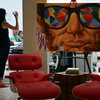
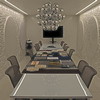
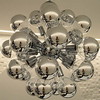
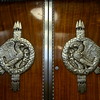
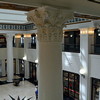
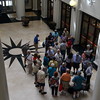 We were back on the busses early this morning but today there was no
single destination. Instead, we would be making several reasonably short
stops. First up is the building that the original Lincoln Highway
Association's headquarters called home. Today it is the
Chrysler House. When it housed the LHA, it was named
the Dime Bank Building after the resident bank where accounts could be
opened with as little as a dime. It looks rather nice no matter what you
call it.
We were back on the busses early this morning but today there was no
single destination. Instead, we would be making several reasonably short
stops. First up is the building that the original Lincoln Highway
Association's headquarters called home. Today it is the
Chrysler House. When it housed the LHA, it was named
the Dime Bank Building after the resident bank where accounts could be
opened with as little as a dime. It looks rather nice no matter what you
call it.
We were divided into several groups and assigned guides to see a bit of the building's interior. It wasn't possible for us to visit the old 21st floor LHA space so we were shown an area occupied by dPOP (Detroit People Offices Places) instead. They claim to be "passionate about designing spaces that inspire both creativity and productivity within the workplace" but you could probably guess that. |
|
|
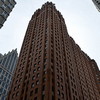
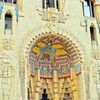
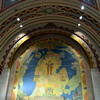
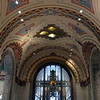
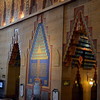
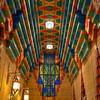 We didn't even need the bus to reach the next attraction. The fabulous
Guardian
Building is less than a block from the Chrysler House. Completed in
1929, it barely avoided the stock market crash. The Wirt C. Rowland
designed structure has been called one of the most significant Art Deco
buildings in the world. It's easy to see why.
We didn't even need the bus to reach the next attraction. The fabulous
Guardian
Building is less than a block from the Chrysler House. Completed in
1929, it barely avoided the stock market crash. The Wirt C. Rowland
designed structure has been called one of the most significant Art Deco
buildings in the world. It's easy to see why.
|
|
|
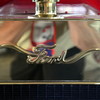
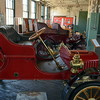
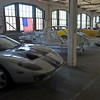
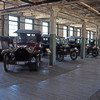
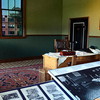
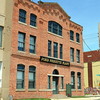 The buses then hauled us to lunch at the
Piquette
Avenue Ford Plant. This is where both the Model T and the assembly
line were developed. Henry Ford's second floor office has been furnished
to match a period photograph and some
modifications have been made to provide a Henry's eye view.
Originally, teams of eight to ten men assembled complete cars between each
pair of support posts. As some workers developed expertise in specific
operations, they moved from car to car performing the same job on each
one. Next, as every schoolboy (or at least every schoolboy of a certain
age) knows, Henry started moving the cars past the employees and the
moving assembly line was born.
The buses then hauled us to lunch at the
Piquette
Avenue Ford Plant. This is where both the Model T and the assembly
line were developed. Henry Ford's second floor office has been furnished
to match a period photograph and some
modifications have been made to provide a Henry's eye view.
Originally, teams of eight to ten men assembled complete cars between each
pair of support posts. As some workers developed expertise in specific
operations, they moved from car to car performing the same job on each
one. Next, as every schoolboy (or at least every schoolboy of a certain
age) knows, Henry started moving the cars past the employees and the
moving assembly line was born.
Many interesting cars are displayed at the factory and we heard some of their stories. Here are two of the things I learned. I knew that many Ford models preceded the Model T and I've seen a few examples of the first Model A (The one that came before the groundbreaking Model T) and the Model B that immediately followed it. What I didn't realize was that they were basically the same car. The Model A was chain driven with the engine and gas tank under the seat. It was started with a crank on the right side. When cars with front mounted engines begin appearing, they were seen as more stylish and maybe even more advanced. Henry got in on the stylishness by moving the gas tank to the front and placing a hood-like structure around it. The rest of the car -- chain, engine, and side crank -- remained the same. I also learned that the Ford logo originally had wings and that the Model Ts made in this building (the first 12,000 or so) can be identified by their wings. |
|
|
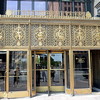
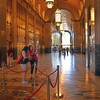
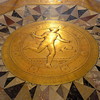
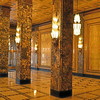
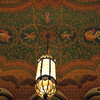
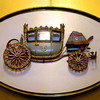 The 1928 Fisher Building only partly escaped the great
depression. Another thirty story tower plus a gigantic sixty story tower
were planned but those plans were abandoned when the stock market crashed.
An information panel mounted inside the building is
here. On the day of our visit, it was announced
that the building was part of a 12.2 million dollar sale to the HFZ
Capital Group.
The 1928 Fisher Building only partly escaped the great
depression. Another thirty story tower plus a gigantic sixty story tower
were planned but those plans were abandoned when the stock market crashed.
An information panel mounted inside the building is
here. On the day of our visit, it was announced
that the building was part of a 12.2 million dollar sale to the HFZ
Capital Group.
|
|
|
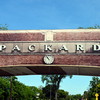
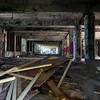
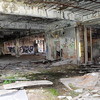
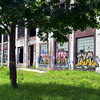
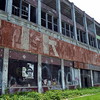
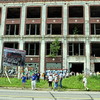 Many pictures have been taken and much has been written about the
forty acre site of the Packard plant. Here's some more. Vandals,
scavengers, and time have certainly done their damage but a little good
news is starting to be heard. Last year, Spanish investor Fernando
Palazuelo bought the site and some cleanup has started. A "wrap"
made from a photograph now covers a badly decayed bridge while work to
restore it reportedl progresses behind the mesh covering.
Many pictures have been taken and much has been written about the
forty acre site of the Packard plant. Here's some more. Vandals,
scavengers, and time have certainly done their damage but a little good
news is starting to be heard. Last year, Spanish investor Fernando
Palazuelo bought the site and some cleanup has started. A "wrap"
made from a photograph now covers a badly decayed bridge while work to
restore it reportedl progresses behind the mesh covering.
|
|
|
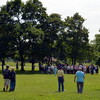 This is, without a doubt, the densest journal page I've ever posted. I
determined early on that six was the maximum number of thumbnails I ought
to include in one panel (That's what I call the areas separated by
horizontal lines.) of a journal page. Six thumb panels aren't exactly rare
but it is unusual to see more than a couple of them on a page. All five
of the preceding panels have six thumbnails and there's one more to come.
More often than not, a six thumb panel means I really had a lot more than
six pictures I wanted to use for a particular subject and that was
certainly the case for the buildings of Detroit.
This is, without a doubt, the densest journal page I've ever posted. I
determined early on that six was the maximum number of thumbnails I ought
to include in one panel (That's what I call the areas separated by
horizontal lines.) of a journal page. Six thumb panels aren't exactly rare
but it is unusual to see more than a couple of them on a page. All five
of the preceding panels have six thumbnails and there's one more to come.
More often than not, a six thumb panel means I really had a lot more than
six pictures I wanted to use for a particular subject and that was
certainly the case for the buildings of Detroit.
It could have been true for the parks of Detroit as well, or at least for Belle Isle, but most Belle Isle features were seen from the bus which isn't really conducive to photo acquisition. I try it on occasion but the combination of moving platform and glaring glass has not been good to me. Since I remembered seeing lots of neat things in the park, I was surprised to find only this single photo at the end of the day. I remember taking the picture and thinking that it looked a bit like farm animals packing into shady areas on hot days. We're sort of packing in for shade, too, but mostly it's for the Vernors and Faygo. |
|
|
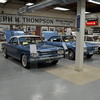
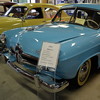
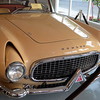
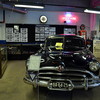
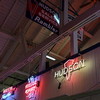
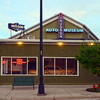 Internet service at the hotel had been flaky from the beginning and
essentially not at all useful for the last couple of days. It was actually
working when the bus tour ended and I took advantage of it to get one page
of this journal posted. That made me late for dinner and that made me late
for Cece Otto's performance at the Ypsilanti Automotive Heritage Museum which, as of last
September, is also the National Hudson Motor Car Company Museum. The building
once housed Miller Motors, the last operating Hudson dealership in the
country. There are plenty of Hudsons on display including a rare Italia
along with the various products of the Ypsilanti area's Willow Run Plant
such as Henry Js and Corvairs.
Internet service at the hotel had been flaky from the beginning and
essentially not at all useful for the last couple of days. It was actually
working when the bus tour ended and I took advantage of it to get one page
of this journal posted. That made me late for dinner and that made me late
for Cece Otto's performance at the Ypsilanti Automotive Heritage Museum which, as of last
September, is also the National Hudson Motor Car Company Museum. The building
once housed Miller Motors, the last operating Hudson dealership in the
country. There are plenty of Hudsons on display including a rare Italia
along with the various products of the Ypsilanti area's Willow Run Plant
such as Henry Js and Corvairs.
|
|
|
| [Prev] [Site Home] [Trip Home] [Contact] [Next] |